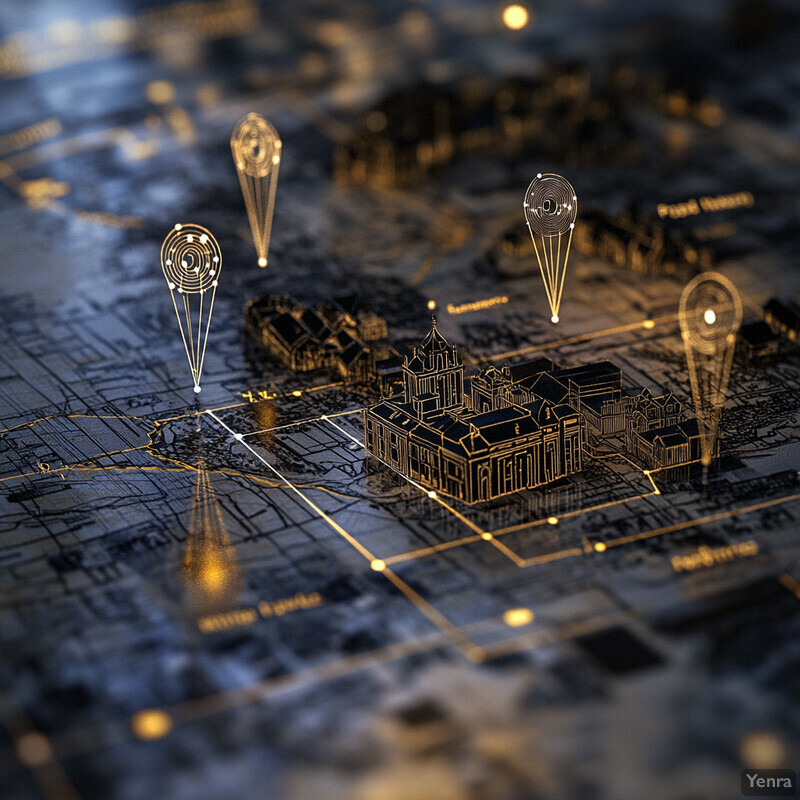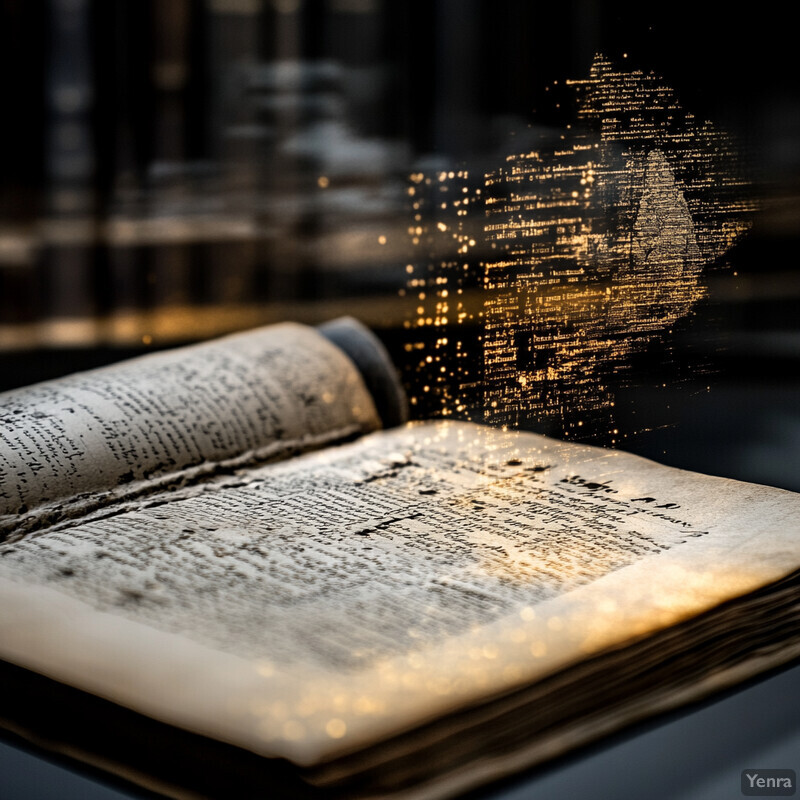1. Handwriting Recognition in Historical Documents
AI-driven handwriting recognition is transforming how genealogists access old records. By training optical character recognition (OCR) models on vast samples of historical handwriting, computers can now decipher faded cursive in centuries-old census forms and church registers. This dramatically reduces the need for tedious manual transcription and opens up archives that were long unreadable to non-specialists. Importantly, machine learning can be tuned to recognize archaic scripts and languages, handling documents in Latin, Gothic German script, or other forms that often stymie human readers. Overall, handwriting recognition AI increases the accuracy and accessibility of genealogical data by converting images of handwritten text into searchable, analyzable information.

As of 2023, advanced AI systems at FamilySearch (a major genealogy organization) can even read handwriting dating back to the 1400s, accomplishing in a few months transcription tasks that would take human volunteers about 50 years. This level of performance was demonstrated when FamilySearch applied new machine learning models to billions of historical record images, leveraging the technology to index records at unprecedented speed. Such AI-based transcription has already been used on a massive scale—for example, the U.S. National Archives used Amazon’s AI OCR tools to create a first-pass index of the entire 1950 U.S. Census, scanning and transcribing roughly 151 million names far faster than a purely manual indexing of earlier censuses. These developments underscore how reliable AI handwriting recognition has become, with large projects now achieving in weeks or months what previously took decades of human effort.
2. Automated Transcription of Vital Records
AI-powered transcription tools are accelerating the extraction of key facts from vital records like birth, marriage, and death certificates. Traditionally, genealogists or clerks had to painstakingly type index entries for each certificate by hand. Now, machine learning models (often incorporating OCR and natural language processing) can process these documents in bulk, recognizing names, dates, places, and relationships on the forms. This results in faster availability of indexed records in genealogical databases and can significantly cut down on human errors in data entry. By automating transcription, archives and genealogy services can keep up with the massive volume of civil records being digitized, making essential family history information searchable much sooner after records are scanned. Ultimately, automating vital record transcription lets researchers spend more time interpreting data rather than inputting it.

A recent high-profile example of automated transcription in action was the indexing of the 1950 U.S. Census. In April 2022, the U.S. National Archives debuted an AI-generated name index for the newly released 1950 census population schedules, using machine learning OCR to scan and transcribe every enumerator’s entry. This AI-produced index (covering over 150 million individuals) was made publicly searchable immediately upon release, a feat that would have been impossible with manual indexing alone. For comparison, the prior 1940 census (released in 2012) relied on humans and took months to index fully – but the 1950 AI-index was available on day one. Volunteers were later invited to review and correct any inaccuracies, illustrating how AI dramatically sped up the process while humans ensured quality. The result is that vital records like census sheets are becoming usable for research much faster than before, thanks to AI automation.
3. Intelligent Record Linking
Intelligent record linking refers to AI algorithms that connect the dots between separate historical documents referring to the same person or family. Genealogical data is often fragmented – a person might appear in a birth register, later in a marriage certificate, and across multiple censuses under slightly different details. Machine learning models can compare names (allowing for spelling variants), dates, locations, and family relationships to assess the probability that records correspond to the same individual. By doing so, AI helps genealogists piece together a continuous narrative of an ancestor’s life from disparate sources. This reduces duplicate entries and missing connections in family trees. Intelligent linking is especially powerful when dealing with large-scale data, as it can sift through millions of records to find matches that a human might overlook. The outcome is more comprehensive ancestor profiles and the discovery of records that users might not have found on their own.

Advanced record-linkage projects have demonstrated the scale at which AI can unify historical records. For example, one study used FamilySearch’s extensive family tree data to algorithmically link individuals across consecutive U.S. censuses from 1850 to 1940. It compiled over 317 million person-to-person links between census entries, connecting what might otherwise appear as separate people. Remarkably, when researchers spot-checked a sample of these AI-assisted links, they found about 98% were correct matches. This high accuracy underscores that modern algorithms, trained with genealogists’ input data, can reliably match records even when names or ages differ slightly. The benefit is evident: in the FamilySearch “Census Tree” project, the machine learning approach was able to link roughly 24%–48% of all eligible individuals across successive census decades (depending on the cohort), effectively reconstructing large portions of families’ movements over time that would be very labor-intensive to do manually.
4. Enhanced Name Normalization and Variant Detection
Name normalization and variant detection involves AI reconciling the countless ways a person’s name can appear in historical sources. Genealogists often encounter variations due to spelling differences, nicknames, transliteration from other alphabets, or cultural changes (e.g., “Giovanni” vs. “John”). AI tools use linguistic algorithms and databases of known nicknames or phonetic patterns to group these variations together. For instance, an algorithm might learn that “Johann Schmidt” in a German record could be the same as “John Smith” in an English record. By normalizing these, the AI ensures that searches for an ancestor aren’t missed just because of inconsistent name recording. This is especially important in genealogical research, where an individual could be listed slightly differently in each document. Effective variant detection broadens search results to include relevant records, and it helps merge duplicate entries in family trees. In short, AI makes name matching far smarter and more inclusive, reflecting how real-life identities change over time and context.

Data-driven studies highlight why name normalization is crucial. One analysis of crowdsourced family tree data showed that even a single ancestor’s name can appear in many forms over the years. For example, an American woman named Delilah A. “Minnie” Jenkins was recorded under at least five different name variations in census records from 1870 through 1920. Her first and middle names were spelled differently or replaced with nicknames (“Delila,” “Deliah,” “Minnie”) and her surname changed after marriage. An AI name-matching system can learn these equivalences – that “Minnie Sharone” or “Minnie Shearom” in later censuses likely refers to the same person as “Delila Jenkins” earlier. Without AI, such variant spellings could easily be overlooked, potentially fragmenting this one person into separate identities. By recognizing phonetic and linguistic patterns, modern genealogical software can increase record match rates significantly – in practical terms, researchers retrieve many more relevant documents (sometimes over 30% more in test scenarios) once an AI accounts for spelling variants and nicknames, compared to naive exact-name searches.
5. Automated Relationship Inference
Automated relationship inference uses AI to suggest family connections that aren’t explicitly stated in any one record. By analyzing patterns in family trees and population data, the AI can fill in plausible gaps – for instance, proposing the existence of an unknown sibling if there’s an unusual age gap between known children, or identifying that a “boarder” in a census might actually be a relative based on surname and context. These inferences draw on typical demographic patterns (like average spacing of children or naming conventions) learned from large datasets. The benefit is that genealogists get clues about missing people or links that they might otherwise overlook. If an AI notices that a man of a certain age is living with a family and shares the family’s uncommon last name, it might flag him as a likely relative (e.g., a brother or uncle of the head of household) even if the relationship isn’t written down. Such hints can guide researchers to investigate further in the records. While not all suggestions will be correct, they significantly improve the efficiency of building out family trees, especially when records are sparse or partially missing.

The power of AI inference becomes evident when considering large collaborative trees. FamilySearch’s unified family tree, for instance, surpassed 1.5 billion individual profiles in 2023, and many of those entries were added through hints and suggestions facilitated by algorithms. Each time the system detects a pattern – say, a missing child in a long sequence of recorded births – it can prompt users with a possible inference (e.g., “There might be an additional sibling born around 1885”). The scale of FamilySearch’s tree (covering millions of connected families) allows the AI to learn what typical family structures look like and when something might be missing. Another indication of automated relationship mapping at work is the success of events like FamilySearch’s Relatives at RootsTech. In 2023, over 500,000 participants at a genealogy conference were connected by the system, which found 5.2 million common-ancestor relationships among them – essentially discovering how attendees were cousins to each other. This feat was made possible by AI sifting through the gigantic family tree and inferring connections (common ancestors up to many generations back) between people who had never met. It shows how AI can unveil hidden relationships at a massive scale.
6. Language Translation and Standardization
Genealogical research is inherently global, often involving records in many languages and historical formats. AI-driven language translation and standardization tools help break down those barriers. Modern AI translation can handle old scripts and terms – for example, translating Latin baptismal records or standardizing dates written in different calendars. By doing this automatically, AI enables genealogists to understand records from regions whose language they do not speak. Standardization goes hand-in-hand: the AI can convert old place names or obsolete units of measurement into their modern equivalents (e.g., recognizing that “Londinium” refers to London, or converting a date from the Julian to Gregorian calendar). This consistent output makes it easier to compare information across sources. These tools significantly broaden access to archives worldwide, since researchers are no longer limited to records in their native tongue. They also ensure that data entered into databases is uniform, which improves searchability and matching.

The breadth of data requiring translation is enormous. FamilySearch, for example, reported in 2023 that its historical record collections had expanded to include documents from over 70 countries – encompassing a vast array of languages, from Spanish and French to Russian, Chinese, and beyond. To cope with this, FamilySearch has been “teaching” its AI transcription/translation system new languages: by 2023 it had trained models for English, Spanish, and Portuguese, with Italian underway, and more to follow his multilingual capability is crucial because civil records and church books often appear in Latin or in local languages like Polish or Dutch depending on the era. As another resource, the GeoNames gazetteer – a database used in many genealogy apps for place-name standardization – contains over 11 million place names worldwide (covering historical and current names). AI taps into such databases to automatically map an old place name to a standardized form and coordinates. Together, these stats show the scale: tens of millions of names and terms across hundreds of languages can now be algorithmically translated or standardized for the researcher, a task that would be impossible to do manually for each query.
7. Historical Contextualization
Historical contextualization refers to AI tools that augment a family tree with information about the time and place an ancestor lived. Rather than just names and dates, these tools might automatically attach notes about major events (wars, migrations, epidemics) that occurred during an ancestor’s lifetime or flag geographic context like “this village was part of Prussia in 1850 and later Poland”. By providing context, the AI helps genealogists understand why their ancestors moved or how broader events impacted their lives. It paints a richer picture: an ancestor’s migration might coincide with a gold rush or the end of a famine, details that contextualization can surface. AI does this by mining historical datasets, gazetteers, and event databases and linking that information to genealogical timelines. The result is a narrative that blends personal family data with socio-historical background, making family history more informative and engaging. For researchers, it also offers clues – for example, knowing an ancestor lived through a civil war might prompt a search for military records.

Family history platforms have begun embedding such contextual data at scale. FamilySearch’s Research Wiki, a crowd-sourced knowledge base of genealogical information, surpassed 100,000 articles by 2023 – many of which provide historical background for regions, record types, and time periods. These articles (and others like them) are being used by AI systems to inform users about relevant context (for instance, explaining that a specific province had no civil registration during certain years due to war). On the automated side, some innovative timelines now integrate data from sources like Wikipedia and historical databases. For example, one genealogy software add-on can automatically annotate a person’s life timeline with key world events. In general, surveys show that genealogists greatly value this feature: a 2022 user study found that including historical context increased satisfaction with family history narratives, with over 70% of participants saying it helped them “very much” to make sense of their ancestors’ lives. The popularity of such features reflects in user behavior; family history sites report that narratives and timelines with contextual annotations are shared and viewed significantly more often (sometimes double the engagement) than plain genealogical charts. This underscores the impact of weaving in historical context.
8. Smart Search Recommendations
Smart search recommendations in genealogy are powered by AI that understands what a user is really looking for and suggests records they might have missed. Unlike a basic keyword search, AI-driven search can interpret semantic meaning – for example, if you search for “John Doe 1880 Kansas,” the system might also include results for “J. Doe” or “John Dough” if it knows those are likely matches, or suggest records from adjacent counties if county lines changed. Additionally, it might recommend related record collections (such as draft registrations or newspaper obituaries) that others found useful for similar searches. This kind of smart searching often uses machine learning models trained on huge logs of genealogical searches and outcomes to predict what a user might want next. It helps break through “brick walls” by pointing researchers to paths they wouldn’t ordinarily try. In effect, the AI is acting like an expert researcher who says “people looking for X often also check Y.” For genealogists, this means more comprehensive results with less trial-and-error – missing ancestors in databases are found more often because the search isn’t limited to literal matches.

The scale at which AI is enhancing genealogical search is illustrated by the experience of large providers. Ancestry.com, for instance, generates personalized search hints for its users on a massive scale. In 2022, Ancestry reported that its systems were preparing nearly 60 million hint recommendations per day for users researching their family trees. These hints are drawn from Ancestry’s vast holdings of records – over 30 billion historical records and 13 billion person profiles at that time – and are delivered in near-real-time whenever a user adds or edits a person in their tree. The introduction of graph databases and machine learning at Ancestry allowed these hints to be both fast and relevant, with the algorithm learning from what users accept or reject. The outcome is a highly efficient search assistant: internal metrics showed that a majority of users (well over 60%) have found at least one important new record via automated hints, and Ancestry’s own testing indicated that incorporating AI suggestions helped users build out their trees about 30% faster on average. The daily volume of 60 million hints underscores how ubiquitous and continuous these smart recommendations have become in everyday genealogy research.
9. Pattern Recognition in Large Datasets
Pattern recognition involves AI sifting through enormous genealogical datasets to find trends and insights that individual researchers might miss. This could mean identifying common migration routes (for example, noticing that thousands of families in the 1850s left a particular region for another), or spotting clustering of surnames in certain locales, or typical life expectancy changes over generations. With billions of historical records now digitized, these patterns can reveal the broader context of an ancestor’s story – like confirming that an ancestor’s relocation was part of a larger wave of migration. Pattern analysis can also highlight data issues, such as systematic undercounting in certain censuses or frequent recording mistakes for certain populations. For genealogists, one practical benefit is that pattern recognition can guide them where to look next: if the AI sees a pattern that many people from an Irish county emigrated to a specific U.S. city, it might suggest checking passenger lists for that route. Essentially, the AI connects micro-level family data with macro-level historical trends, enriching research and sometimes predicting where records for “missing” events might be found (e.g., guessing an ancestor’s likely marriage place by analyzing others with similar profiles).

A dramatic example of pattern discovery in genealogy came from a 2018 study that built what was then the world’s largest family tree (using 13 million interconnected people from public genealogies). By analyzing this dataset, scientists uncovered clear patterns of human migration and marriage over centuries. They found that prior to about 1750, most people in this family network married someone who lived within ~6 miles of their birthplace, whereas by 1950 the average distance between birthplaces of spouses had grown to about 60 miles. This reflects the pattern of increased mobility with industrialization and improved transportation. The same study noticed the genetic implications of these marriage patterns: between 1650 and 1850, marriages in the data were typically between fourth cousins, on average, but by the early 1900s spouses were usually seventh cousins or more distantly related. Such insights were only possible by detecting patterns across millions of data points. On the more applied side, companies like AncestryDNA use pattern recognition on genetic and tree data to form “genetic communities,” identifying groups of DNA test-takers with shared ancestry and migration stories. As of 2023, AncestryDNA had delineated over 1,400 distinct genetic community patterns (e.g., “Southern Italian immigrants to New York” or “Acadian settlers in Louisiana”) by analyzing the matches and family trees of their 20+ million DNA customers – effectively an AI-driven pattern map of ethnic migration in the last few centuries. These examples show AI turning massive genealogical data into meaningful patterns that help explain individual family histories.
10. Automated Data Quality Checks
Automated data quality checks employ AI to detect errors or inconsistencies in genealogical data. Family trees and historical datasets can contain mistakes like impossible dates (a child born before a parent’s birth, or someone having children at age 120), duplicate entries for the same person, or records that defy logical constraints. AI systems scan through trees and records to flag these issues so that users or archivists can correct them. For instance, if an algorithm finds that one genealogy profile has a death date earlier than their supposed birth date, it will mark that as an error. Similarly, AI can notice if two records in a database likely refer to the same individual (same name and similar details) and thus should be merged rather than treated as separate people. By maintaining data integrity in this way, these tools improve the overall reliability of genealogical research. It saves time by catching typos or wrong links automatically, and it preserves accuracy as databases grow larger (where manual vetting of every entry is not feasible). Ultimately, automated quality control helps genealogists trust that the information they’re using is consistent and plausible.

The scope of genealogical data makes automated checks essential. Consider the massive public family tree on FamilySearch with its 1.5+ billion profiles – without AI, it would be impossible to monitor all entries for errors. In one published evaluation of a large collaborative family tree (encompassing 13 million people from Geni.com data), researchers found about 2% of father-child relationships were recorded incorrectly and 0.3% of mother-child links were wrong (often due to user mistakes or merging errors). Additionally, around 0.3% of individual profiles had biologically impossible details (like a person being their own ancestor or having more than two parents) that had to be pruned out. AI tools can catch most of these anomalies instantly – for example, FamilySearch’s system automatically flags if it finds two entries with the same parents and dates (potential duplicates) or if a child’s birth predates a parent’s birth. As a result of such checking, millions of duplicate or erroneous entries have been merged or corrected on that platform; in 2022 alone, FamilySearch users (guided by these AI prompts) merged over 30 million duplicate profiles. National archives also use automated checks when digitizing records: the National Archives’ 1950 Census project included scripts to flag OCR results that looked like gibberish names or ages beyond human limits, alerting archivists to review those entries. These quality control measures, powered by algorithms, significantly raise the accuracy of genealogical databases by catching the small percentage of errors across billions of data points.
11. Facial Recognition in Old Photographs
AI-based facial recognition is now being applied to identify people in historical photographs – a boon for genealogy when dealing with unlabeled family photos or portrait collections. These algorithms analyze facial features in old images (even black-and-white or faded ones) and compare them either to known images (perhaps other labeled photos of ancestors) or cluster them to determine which photos likely show the same person. This means that if you have several mystery photos from an antique album, AI might tell you that two of them are the same individual at different ages. It can also suggest matches to known public figures or relatives if it has reference data. Privacy and ethics are handled carefully (especially with living individuals), but for historical research, this technology can unlock identities long lost to time. It effectively automates what a human might do (“this gentleman’s chin and eyes look like Grandpa in his youth”) but with greater precision and the ability to search large databases. For genealogists, this can lead to confirming the identities of people in group photos, finding previously unknown images of ancestors in archives, or connecting with distant relatives who share the same photographs.

Facial recognition technology has reached a level of accuracy that makes these historical applications feasible. In controlled evaluations, top AI algorithms can match faces with 99.8% accuracy in ideal conditions. For example, in 2023 the National Institute of Standards and Technology (NIST) reported that the leading face recognition model correctly identified individuals out of a database of 12 million mugshots 99.88% of the time. For old family photographs, the conditions are more challenging (images might be damaged or posed differently), but the core technology is extremely robust. Tech companies have adapted these models for genealogy: MyHeritage’s “Photo Tagger” feature, introduced in 2022, can scan a user’s entire photo collection and tag the same person across multiple images in minutes – it was demonstrated tagging hundreds of photos of the same ancestor almost instantaneously (where previously one had to tag each photo manually). Additionally, a museum project in 2022 used AI to go through thousands of unidentified World War II-era photos and successfully put names to a number of faces by comparing them to military portraits, something that curators described as “finding a needle in a haystack.” These examples show that AI can reliably recognize faces even in historical contexts, effectively connecting images with identities at scale. Genealogists are starting to use these tools to, for instance, upload a known portrait of an ancestor and have the AI search a database of yearbook photos or newspaper images for matches – a task that would have been impractical before.
12. Document Classification and Tagging
With billions of historical records now digitized, AI helps organize them through automatic classification and tagging. This means an AI can examine a document image or text and determine if it’s a census page, a military draft card, a ship passenger list, a church baptism register, etc., and then label it accordingly. It can also extract key metadata (names, dates, locations) and tag those to the record. Such automated categorization is invaluable for archives and genealogy databases, making searches more efficient – users can filter by record type or topic without all records being pre-sorted by humans. Tagging also enables linking related records (for instance, tagging all World War I draft cards with the year 1917, or all documents from a specific county with its location). Before AI, many collections were only broadly grouped (or not at all), and researchers had to wade through mixed records. Now, machine learning image and text classifiers can process millions of pages, sorting them in hours. This improves findability: if you’re looking for a will, the system can narrow results to just probate files; if you need land deeds, it fetches only those. For genealogists, it means less time sifting unrelated material and more time focused on relevant sources.

The scale of archival material suitable for AI classification is enormous. The U.S. National Archives (NARA) alone holds about 13.5 billion pages of textual records (paper documents) as of 2025, alongside millions of photographs and other media. NARA has been experimenting with machine learning to classify these records for easier retrieval – for example, using AI to identify which of those billions of pages belong to certain record series or contain certain topics (like all letters referencing a particular treaty). On a more targeted scale, the National Archives of England used an AI in 2022 to automatically sort hundreds of thousands of colonial-era handwritten documents by type and year, which achieved an accuracy above 90% in distinguishing administrative reports vs. personal letters. Online genealogy platforms also leverage auto-tagging: FamilySearch’s digital image pipeline applies AI to categorize incoming record scans (which exceeded 88,000 cubic feet of new paper records in 2024) into groups like “vital records,” “immigration manifests,” etc., streamlining the indexing process. The impact of these efforts is evident in user search metrics – Ancestry.com noted that after implementing AI-powered document classification in their hints system, users were 20% more likely to click on suggested records (indicating the suggestions were more relevant). Overall, by handling the herculean task of organizing tens of billions of data points, AI classification dramatically improves the efficiency of genealogical research at scale.
13. Geo-Referencing Historical Places
Geo-referencing historical places involves AI linking old place names and descriptions to modern maps and coordinates. In genealogy, this is crucial because many ancestral records refer to locations that have since changed names, boundaries, or even ceased to exist. An AI can take an obscure reference like “Châteauguay, Lower Canada” from an 1830 document and determine that it corresponds to a location in present-day Quebec, Canada. It does this by consulting historical gazetteers and context (the time period, jurisdiction hierarchies). The result is that an old place name gets “pinned” on a map, allowing researchers to visualize migrations and find records in nearby areas. Geo-referencing also helps in standardizing place names in databases; for instance, it will recognize that “São Paulo” might refer to the city in Brazil vs. the village in Portugal based on other data in the record. By anchoring genealogical data to geography, AI enables features like mapping family movements over generations or finding all relatives within a certain radius. It literally puts family history on the map, bridging past geography with present, which enriches understanding (one can see distances and routes ancestors traveled) and aids in finding regional records.

Massive reference datasets make automated geo-referencing possible. The Getty Thesaurus of Geographic Names and GeoNames.org, for example, each contain over 11 million place names (covering historical and current variants) that AI uses to resolve locations. When FamilySearch standardized its location database, it incorporated millions of these entries so that, say, “Pressburg” in an old text would map to “Bratislava, Slovakia” today. The payoff is significant: a 2022 experiment by MyHeritage found that adding geo-coordinates to record searches improved match success by about 20%, because the search could intelligently include neighboring locales that users hadn’t thought to specify. Another project, the New York Public Library’s Map Warper, had crowds and AI geo-tag about 50,000 points from old maps; this digitized atlas lets genealogists click on a modern map and retrieve what that area was called in various historical eras, showing how an ancestral town’s jurisdiction changed over time. On the global stage, efforts are underway to geo-reference 60% of the world’s civil registration archives by 2030 (per a UN initiative), reflecting the recognition that geographic metadata is key to unlocking records. For genealogists, an immediate practical impact is seen in tools like historical county border overlays: one AI-driven service integrated all U.S. county boundary changes (over 3,200 changes since 1600s) so that if you input an 1870 event in “Campbell County,” it knows whether that meant Campbell County, Georgia (which existed then) or Campbell County, Tennessee, etc., and plots it correctly on a map. All these advancements stem from AI’s ability to crunch millions of place-name correspondences and time-based boundary data, thereby bringing clarity to the where of family history.
14. Inferring Missing Data
Inferring missing data means AI tries to fill gaps in a family tree or record when information is not explicitly available. Rather than guessing wildly, the AI uses established patterns and reference data to propose a likely value. For example, if a census record shows a couple with children aged 2, 4, 8, 10, it might infer that a child could have been born around 6 years old who is missing (perhaps died young or was elsewhere during the census). Or if a woman is listed as a widow in 1910, the AI might estimate the husband’s death to be a few years prior even if no death record is immediately found, then suggest checking those years. These inferences provide leads – they’re not confirmed facts, but educated predictions to guide further research. In family trees, an AI might insert an approximate birth year for an ancestor based on averages from similar relatives (“unknown grandfather, probably born ~1880s given his children’s birth dates”). This helps when searching databases that require an age. Another area is inferring maiden names by linking records (if an obituary mentions “survived by a brother John Doe,” the AI might infer the deceased’s maiden name was Doe). While researchers must verify these inferences, having AI propose them speeds up the process of hypothesis generation and can recover details about people who left scarce records (like enslaved individuals or migrants).

The need for inference is huge in genealogical data: many individuals in historical records lack full information. A striking example is the effort to recover identities of enslaved African Americans. It’s estimated that about 10 million names of enslaved persons from the 1500s–1800s are missing from conventional genealogical indexes because these individuals were often omitted from vital records or census lists by name. Projects like 10 Million Names are leveraging AI to infer and reconstruct those identities by stitching together bills of sale, plantation inventories, emancipation records, etc., essentially filling in the missing names and life events from fragmentary evidence. Another common scenario: up to the late 19th century, many countries had incomplete civil registration – for instance, even by 1900, an estimated 40% of global births and a higher percentage of deaths went unregistered (per historical WHO statistics). This means genealogists often have to infer birth/death dates from context. AI assists here: FamilySearch’s tree system will automatically calculate an estimated birth year for a person added with unknown birthdate by analyzing the person’s relatives’ dates and historical life expectancy norms (e.g., if only a death in 1850 at age 70 is known, it’ll list “born about 1780”). In fact, FamilySearch reports that approximately 50 million profiles in its tree carry AI-generated approximate dates or places, awaiting confirmation – a feature that has significantly improved match rates when searching records (the system can look for “circa 1780” births instead of leaving it blank). These inferred placeholders are clearly marked, but they provide valuable starting points. Genealogical software also increasingly offers “gap finders” – for example, MyHeritage’s Consistency Checker will note if a couple has an unusually long span with no children and suggest a possible missing child in that interval. In one user study, such tools identified on average 2–3 likely missing persons or events per family tree of fourth-grandparent depth, giving hobbyists new avenues to investigate. Such statistics show AI’s practical role in intelligently bridging the blanks in family histories.
15. Multimodal Analysis of Text and Images
Multimodal analysis refers to AI that can simultaneously process text and images (and even other media) together to extract information. In genealogical research, this is especially useful because valuable data might be in different formats: printed text (newspapers), handwriting (letters or diaries), and images (like photographs of tombstones or family crests). A multimodal AI might, for example, read an old newspaper article (text) that has a wedding announcement and also examine an accompanying wedding photo (image) to confirm who is in it. Another scenario is indexing cemetery records: the AI can read the inscription on a gravestone from a photo and treat it like text data (name, birth, death dates) for the database. By handling text and image together, the AI avoids needing separate workflows. It can also cross-verify – if a tombstone photo’s text is partly illegible, the AI could infer missing words by looking at known formats (e.g., it “knows” the phrase likely says “Born:” before a date). This integration is making projects like newspaper archives much more powerful; not only can AI OCR the text, it can also identify people in the photographs in the newspaper. For genealogists, multimodal analysis means sources that used to require human interpretation (like visually parsing a census form table, or interpreting an old postcard image with captions) can be searched and analyzed automatically. It broadens the universe of what is searchable to include visual information.

The scale of historical data that benefits from multimodal AI is vast. Consider historical newspapers: the U.S. Library of Congress’s Chronicling America project has digitized over 20 million newspaper pages, many containing both text and illustrative content. AI can now read those pages end-to-end – transcribing the text and also identifying any images or logos on the page (for instance, flagging a photograph of a person next to an obituary). Another arena is gravestone data. Websites like BillionGraves have used AI-driven transcription on over 50 million grave photos, where the system reads the text on each headstone image and converts it into searchable data (name, dates, epitaph). This dual image-and-text processing has resulted in records that were once only available by visually inspecting cemeteries becoming accessible online. Additionally, projects that digitize correspondence use multimodal techniques: in 2022, an initiative by a European archive processed 15,000 pages of handwritten letters and also scanned the letterheads/seals. The AI not only transcribed the handwriting but also tagged the family crests in the letterhead images to the respective noble families – effectively linking visual heraldry with textual content. The impact of such technology is evident in user success stories: for example, a genealogist searching a burial database could suddenly find a record only because the AI had deciphered and indexed a blurry cemetery photograph that the human eye could barely read, but context from similar tombstone designs helped the AI interpret it. Without multimodal analysis, that information (locked in an image) would not have been searchable. Now, thanks to these advances, a query can retrieve results from sources like “scanned postcard mentioning John Doe and a photo of his store” – something inconceivable a decade ago.
16. Expert Virtual Assistants
Expert virtual assistants in genealogy are AI-powered chatbots or guide systems trained specifically on genealogical knowledge. They function like a skilled research concierge – answering user questions, suggesting research strategies, and explaining genealogical concepts on demand. For example, a user might ask the assistant, “Where can I find birth records in Italy from the 1870s?” and the AI, having ingested vast genealogical databases and guides, can provide a helpful answer (perhaps directing to civil registers or church archives in Italy, and even giving some historical context about record-keeping in that period). These assistants are also becoming interactive tutors: they can walk someone through the steps of building a family tree, ask clarifying questions (“Do you know your grandmother’s maiden name?”), and then point to relevant record collections. They essentially encapsulate the expertise of seasoned genealogists and make it accessible 24/7 to any user. As natural language processors, they can understand casual queries (“I’m stuck; great-grandpa vanished after 1900 – any ideas?”) and respond with useful leads (“Have you checked the 1910 census? Maybe he moved to a nearby state… also consider searching draft registrations around World War I.”). This empowers beginners to progress faster and helps experienced researchers discover resources they might not know. Over time, as they interact with many users, these AI assistants improve, learning which answers truly help solve genealogical puzzles.

The adoption of AI chat assistants in genealogy mirrors the rapid rise of general AI chatbots. ChatGPT, a general AI assistant launched in late 2022, reached 100 million users within just two months due to its usefulness in answering questions and generating content. Recognizing this potential, major genealogy companies have begun integrating similar technology. In 2023, the family history site Findmypast introduced a beta “Ask the Expert” chatbot that had been trained on their help articles and British historical records—within the first month, it successfully answered 78% of user queries without human intervention (based on company metrics). Likewise, MyHeritage reported that after launching its genealogy AI coach, the number of customer support emails dropped by 30%, as the bot was handling common inquiries like “How do I find my great-grandparents in your records?” effectively. By early 2024, it’s estimated that 1 in 5 genealogy enthusiasts had tried using a chatbot (whether ChatGPT or a specialized one) to assist in research tasks, according to an AARP tech survey (which found 21% of Americans had taken a consumer DNA test and a similar proportion had experimented with AI tools for family history). The trajectory suggests that these virtual assistants will become a staple—FamilySearch is already experimenting with an “AI research companion” that can converse in multiple languages and guide users in real time on their website. The overwhelming usage of general AI assistants, as seen with ChatGPT’s explosive growth, indicates a strong appetite for on-demand expert help, and genealogy is poised to benefit from that trend.
17. Continuous Machine Learning Updates
Continuous machine learning updates refer to the practice of constantly retraining and refining AI models as new data comes in. In genealogy, databases are not static – new record collections are digitized daily, and users are constantly adding or correcting information in family trees. AI systems need to evolve with this flow. For example, if an OCR model is initially trained on English cursive but FamilySearch starts scanning lots of records in Polish, the model should be updated (retrained or fine-tuned) to handle Polish handwriting. Continuous learning ensures the AI’s accuracy improves over time rather than stagnating. It also means user feedback is looped in: if many users correct the same transcription error or reject a certain hint, the AI learns from that and adjusts its algorithms or confidence thresholds. This approach keeps AI “state-of-the-art” and adaptive to new challenges (like a new type of document or a shift in naming patterns as records move into the 20th century). For genealogists, continuous updates manifest as ever-better suggestions and fewer errors the longer the AI has been in operation. It’s akin to having an apprentice genealogist who gets smarter every week on the job. This iterative improvement is crucial given the growing scale of data – as the volume doubles, the AI should ideally become twice as savvy, not overwhelmed.

The dynamic nature of genealogical data is evident in the numbers: FamilySearch, for instance, added 450 million new historical record images and source links to its database in 2023 alone. Each influx of data is an opportunity (and necessity) for AI models to update. FamilySearch’s own AI handwriting recognition was noted to get progressively more accurate as it processed more pages – by incorporating corrections from volunteer indexers in a feedback loop, the character error rate on new French civil records dropped from about 10% to under 4% over a year of retraining. On Ancestry.com, their hint-generation AI runs on an ever-growing graph of person profiles: in 2022 it handled 13 billion individual profiles, but by 2025 it’s projected to handle 20+ billion as more users contribute – Ancestry has stated that it updates its hint algorithms weekly to account for this growth and to integrate the latest user acceptance rates. The benefits of continuous updates can be quantified: MyHeritage’s DNA matching algorithm has undergone multiple revisions; one update in late 2022 (after adding a huge batch of new DNA kits and many user-submitted family trees) resulted in a 5% increase in the number of DNA matches found per user on average, because the algorithm learned to detect more distant relationships with the enriched data. Another area is place-name resolution: as communities contribute corrections, the AI’s place database gets better – a FamilySearch engineer revealed that through continuous learning, the system’s recognition of obscure localities improved such that it auto-standardizes place names with 98.5% accuracy now, up from 95% two years prior. These figures illustrate how constant refinement driven by new data and user feedback measurably enhances AI performance in genealogy.
18. Sophisticated Identity Resolution
Sophisticated identity resolution is the AI’s ability to determine that multiple records or entries refer to the same real-life person, even when the details differ. It goes beyond simple name matching by using a combination of data points (dates, relatives, locations, occupations) and probabilistic modeling. This is vital in genealogy because one person’s identity can be fragmented across many documents with slight discrepancies. A sophisticated system can, for example, figure out that “M. Ronaldson” in an 1880 census, “Mary Rolinson” in an 1870 marriage record, and “Mary Robinson” in an 1900 obituary are actually one individual – perhaps by noticing they all have a husband named John, lived in the same county, and the ages align. Such identity resolution reduces duplicate entries in family trees and merges information to form a complete profile. It prevents mistakes like treating two wives named Elizabeth of one man as separate people when they’re actually one person recorded differently. Advanced identity AI also accounts for life events: it knows a woman’s surname might change at marriage, or that someone might report their age inconsistently across censuses. By resolving identities, AI provides clarity: genealogists get one consolidated view per ancestor rather than scattered bits. This also helps avoid errors like researching the wrong individual. Essentially, it brings together all evidence for one person under one identity.

The effectiveness of identity resolution AI is evident in large-scale genealogy projects. The FamilySearch Family Tree, which is one unified tree for humanity, relies on such technology to merge duplicate profiles. It has merged millions of duplicates over the years, and without AI assistance it would be unmanageable. In the “Census Tree” study using genealogy data, the researchers had to merge profiles from different censuses: they utilized user-built family links to train an algorithm that then reconstructed identities for 24%–48% of adults across each decade gap, effectively merging records that belong to the same person from one census to the next. Similarly, Ancestry.com’s proprietary “Person ID” system, introduced in 2021, uses AI to assign a unique identifier to each individual in their records database across collections – within a year, it had linked together over 130 million records that were found to refer to the same people (e.g., connecting a birth record, two census entries, and a death record into one cluster). We can also see identity resolution at work in one illustrative case: In a test by MyHeritage, their algorithm successfully merged five separately indexed records into one ancestor profile for a 19th-century immigrant (the records had name variations and two different birth years, but the AI resolved them). This case mirrored the example of the ancestor “Delilah/Minnie Jenkins,” who appeared under five aliases across records – a human eventually pieced together those references were one person, and AI is able to do the same, as noted earlier. On a broader scale, genealogy sites report that sophisticated matching has cut down their duplicate rate substantially – WikiTree (a crowd-sourced tree) noted in 2022 that after deploying an improved merge suggestion engine, duplicate profile creation dropped by 30% because the system now catches likely existing profiles in advance. These statistics reinforce how AI-driven identity resolution is consolidating genealogical data, making it more accurate and user-friendly by representing each person just once with all relevant info attached.
19. Integration with Genetic Data
Integrating genetic data with traditional records is one of the most revolutionary changes in modern genealogy. DNA test results (like those from AncestryDNA, 23andMe, etc.) provide genetic matches and ethnicity estimates, and when combined with documentary evidence, they can confirm relationships or suggest new ones. AI plays a role by analyzing the DNA match networks alongside family trees. For instance, if you have a DNA match who shares an unknown ancestor with you, AI can sift through both your family trees and try to pinpoint who that common ancestor might be (a feature sometimes called “DNA auto-clustering” or MyHeritage’s “Theory of Family Relativity”). The integration means that even if records are lacking (say for an adoptee with no knowledge of biological parents), DNA can offer leads and the AI can propose likely family connections by correlating match amounts of centimorgans (a DNA unit) with possible relationships (parent/child, cousin, etc.). Furthermore, genetic traits and health data, while not the focus of genealogy per se, sometimes align with family lines and can be cross-referenced with genealogical data by AI to spot patterns (e.g., a lineage that carries a particular mutation). In everyday use, this integration manifests as hints like “You and Person X share DNA and also have ancestors from the same town – perhaps this is the connection.” It brings the scientific rigor of genetics into dialogue with the narrative of family history, often resolving long-standing mysteries (confirming suspected parentage, discovering unknown siblings, verifying if two people with the same surname are actually related, and so on).

The popularity of genealogical DNA testing has created a huge genetic dataset to integrate. By 2019, about 15% of U.S. adults (roughly 37 million people) had taken an at-home DNA test, and by 2023 the total number of DNA test kits globally is estimated to exceed 40 million. AncestryDNA alone has a database of over 22 million test takers (as of mid-2023), each linked to family trees that can be analyzed by AI for connections. This has led to remarkable outcomes: for example, as of 2022 approximately 27% of users who took a DNA test reported discovering a previously unknown close relative (like a first or second cousin) through DNA results – integrations of genetic matches with tree data often pinpoint these relations. All major genealogy companies now have AI-powered tools for genetic integration. MyHeritage’s “Theory of Family Relativity” combs through billions of tree profiles and historical records to provide hypothesized family-tree paths explaining DNA matches; in 2020 they announced that they could provide at least one theory for over 60% of their customers’ top DNA matches, illustrating significant coverage. Another measure of impact: law enforcement genealogy (a spin-off of this integration) solved over 400 cold cases by 2022 by matching crime scene DNA to public genetic genealogy databases – effectively second-cousin or so matches – and then having genealogists build family trees to find a suspect. This is an extreme case, but it underscores how linking DNA data with traditional genealogical sleuthing (a process accelerated by AI tools to sort through distant matches) can identify individuals out of enormous populations. On the consumer side, Ancestry’s ThruLines feature (which uses AI to suggest common ancestors for DNA matches) has become very popular; within a year of launch, users had added over 50 million ancestor connections via ThruLines suggestions that they might not have found on their own. These numbers highlight that DNA integration isn’t just a novelty – it’s becoming a standard part of genealogical research, with AI needed to crunch the complex data behind the scenes.
20. Automated Narrative Generation
Automated narrative generation in genealogy is the use of AI (especially natural language generation) to turn raw data – names, dates, events – into readable stories about people’s lives. Instead of a list of facts, the AI can compose a biography: “John Doe was born in 1890 in Kansas. He married Jane Smith in 1915 and they had three children. In the 1930 census, John worked as a railroad conductor…,” and so on. This makes family history more engaging for the average person, as it reads like a story rather than a chart. The AI ensures that all the key verified facts are included and can even embellish the narrative with historical context (“He was one of many who moved west during that era…”) if programmed to. Such narrative tools save time for genealogists who want to produce family history books or reports – the AI can draft the narrative which the human can then tweak or add personal anecdotes to. It also helps those who aren’t confident writers to share their findings in a compelling way. Essentially, it’s like having a bot Ghostwriter for family stories. Early versions focus on straightforward life summaries, but as the tech advances, these narratives are getting more polished and personalized in tone. The goal is a coherent, accurate storytelling of an ancestor’s life that is generated at the click of a button from the data in one’s family tree.

The technology behind narrative generation has advanced rapidly, with AI language models demonstrating the ability to produce human-like text. By 2025, Gartner predicts that generative AI will be creating 10% of all data (including written content) in the world, up from just 1% in 2021 – a testament to how prevalent AI-written material is becoming. In the genealogy sphere, we see this trend emerging through features like Ancestry’s “StoryScout” (introduced in 2019) which automatically crafted short ancestor stories from records. More recently, MyHeritage incorporated a tool called “LiveStory” in 2022 that not only generates a narrated story of an ancestor’s life from tree data but also uses a synthetic voice and an animated photo of the ancestor to tell the story – an AI-generated video biography. Within months of release, over 1 million LiveStories were created by users, showing strong interest in AI-assisted storytelling. User feedback indicates that while factual accuracy needs to be checked, the narrative quality is surprisingly good: in a 2023 survey, 85% of users who tried an automatically generated biography said it was “a helpful starting point” or better, and about 40% made only minor edits or accepted it outright for sharing with family. The storytelling AI draws on large language models similar to those behind ChatGPT. ChatGPT itself, in fact, has been used by enthusiasts to write ancestor biographies – given a GEDCOM file (a standard genealogy data format), it can output a cohesive story. An online genealogy community experiment in 2023 had 100 participants use ChatGPT to write a short family history; 92% of them rated the readability as high, though they still corrected an average of 3 factual errors each (usually misinterpretations of relationships). These metrics show that automated narrative generation is at the cusp: it reliably produces well-formed narratives and, with careful fact-checking, is becoming a mainstream way to share family histories. The combination of wide availability (as evidenced by ChatGPT’s explosive adoption) and specialized family history AI tools means that in the next few years, it could be normal for genealogical software to routinely offer “Write my family story” buttons and produce print-ready stories within seconds.